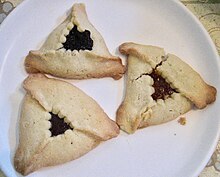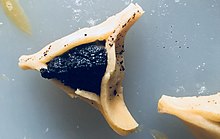 Hamantashen served Hamantashen served | |
| Alternative names | Oznei Haman |
|---|---|
| Type | Cookie or pastry |
| Place of origin | Ashkenazi Jewish communities |
| Variations | Filling: traditionally poppy seed or prune |
A hamantash (pl.: hamantashen; also spelled hamantasch, hamantaschen; Yiddish: המן־טאַש homentash, pl.: המן־טאַשן homentashn, 'Haman pockets') is an Ashkenazi Jewish triangular filled-pocket pastry associated with the Jewish holiday of Purim. The name refers to Haman, the villain in the Purim story. In Hebrew, hamantashen are also known as אוזני המן (oznei Haman), meaning "Haman's ears". "Haman's ears" also refers to a Sephardic Purim pastry, "Orejas de Haman", thought to originate in Spain and Italy, that is made by frying twisted or rolled strips of dough.
Traditionally, the dough for hamantashen was made with yeast. With the invention of baking powder during the 1840s and its wide adoption during the first half of the twentieth century, baking powder supplanted yeast, and hamantashen dough became a cookie rather than pastry dough. To shape a hamantash, a filling is placed in the center of a circle of dough, which is then either folded in half and shaped into a triangle or the sides are brought to the center to form a triangle. The oldest and most traditional filling is mohn (poppy seed paste), with powidl or lekvar (prune jam) a close second. The cookie dough variety has spawned many different fillings, traditionally sweet (although savory varieties have become popular as well). Most popular are various jams, especially apricot and raspberry, but also date, raisins, apple, vanilla pastry cream with chocolate chips, cherry, fig, chocolate, dulce de leche, halva, caramel, or cheese. The dough varies from hard like shortbread to a soft yeast dough.
Etymology and symbolism
In Yiddish, the word homentash is singular, while homentashn is the plural form. However, hamantashen is the more common word form among English speakers, even when referring to a single pastry (for example, "I ate a poppy seed hamantashen").
Hamantash is also spelled hamentasch, homentash, homentasch, homentaschan, or even (h)umentash. The name hamantash is commonly viewed as a reference to Haman, the villain of Purim, as described in the Book of Esther. The pastries are supposed to symbolize the defeated enemy of the Jewish people. The word tash means "pouch" or "pocket" in Yiddish, and thus may refer to Haman's pockets, symbolizing the money that Haman offered to Ahasuerus in exchange for permission to destroy the Jews. In Hebrew, tash means "weaken", and the hamantash may celebrate the weakening of Haman and the hope that God will weaken all of the enemies of the Jews.
Another possible source of the name is a folk etymology: the Yiddish word מאָן־טאַשן (montashn) for a traditional delicacy, literally meaning "poppyseed pouch", was transformed to hamantashen, likely by association with Haman or inclusion of the Hebrew article ha- (ה). In Israel, hamantashen are called oznei Haman (Hebrew: אוזני המן), Hebrew for "Haman's ears" in reference to their defeated enemy's ears, although "Haman's ears" also refers to a Sephardic Purim pastry that is twisted or rolled and fried.
The reason for the three-sided shape is uncertain. There is a 20th-century legend that Haman wore a three-cornered hat. Alternatively, the Midrash says that when Haman recognized the merit of the Three Patriarchs, his strength immediately weakened. Naked Archaeologist documentarian Simcha Jacobovici has shown the resemblance of hamantashen to dice from the ancient Babylonian Royal Game of Ur, thus suggesting that the pastries are meant to symbolize the pyramidal shape of the dice cast by Haman in determining the day of destruction for the Jews.
A simpler explanation is that the shape derives from traditional Jewish baking techniques in Central Europe for folding dough so as to form a pouch around a filling, also common for making dumplings. It has also been suggested that the shape is representative of female reproductive organs, and that the poppy-seed filling is a fertility symbol.
Sweet fillings

Sweet hamantashen fillings range from traditional options such as mohn (poppy seed), powidl or lekvar (prune), apricot jam, and date (especially popular in Israel) to raisin, apple, cherry, fig, chocolate, dulce de leche, halva, caramel, and cheese.
Prune
The prune hamantash was invented in 1731 by David Brandeis of Jung-Bunzlau, Bohemia. The daughter of a Christian bookbinder purchased from Brandeis powidl (plum jam) which she claimed had made her family ill, as her father coincidentally died a few days after eating it. The burgomaster of the city ordered the closure of Brandeis's store and imprisoned him, his wife, and son for selling poisonous food to Christians. Investigations by municipal authorities and the court of appeal in Prague revealed that the bookbinder had died of consumption and the charges were dismissed.
Brandeis wrote a scroll which he called Shir HaMa'alot l'David ("A Song of Ascents to David"), to be read on 10 Adar, accompanied by a festive meal. He was freed from prison four days before Purim after the charges against him were proven to be false, and in celebration of his release, Jews from his city celebrated with povidl or plum hamantashen.
Savory fillings
Savory hamantashen fillings have emerged in recent years, and their popularity has grown and are commonly prepared at home but can also be found in various Jewish bakeries and restaurants serving Jewish cuisine. Savory varieties may have fillings such as pizza ingredients, spinach and feta, lamb, potato, or cheese, and are often somewhat similar to other Jewish pastries such as the knish, bourekas, and sambusak.
Preparation



Sweet hamantashen are typically made with a dough containing butter or less commonly a pareve dough containing oil. Depending on the ingredients used in the dough, the consistency of the finished baking powder hamantash can range from dry and crumbly like shortbread, to soft and cakey like a black and white cookie, to firm and crisp like a butter cookie. The dough is generally prepared with flour, eggs, sugar, butter (or margarine or cooking oil), and a flavoring such as vanilla (or sometimes cocoa, grated lemon rind, rose water, or orange blossom water); sometimes milk is used in the dough; and usually a leavener such as baking powder or baking soda is added as well. The dough is then mixed gently so as to incorporate all the ingredients together without making the dough tough.

The dough is allowed to rest in the refrigerator and then is removed and rolled out to a thickness of between 1⁄8–1⁄4 inch (0.3–0.6 cm). Rounds of dough are stamped out and often brushed with an egg wash to encourage sealing prior to the addition of the filling (or the finished hamentash is brushed with egg wash before baking to produce a shiny golden surface). The most popular filling is poppyseed, but apricot, prune, strawberry, raspberry, chocolate, peanut butter and jelly, and others are also common. The bottom and the top two corners of the dough are folded inward but do not fully enclose the filling, allowing it to remain visible. Sometimes hamantashen may be frozen for a short period of time after shaping in order to prevent leakage of the filling. Then they are baked in an oven at medium heat for a short time. Sometimes after baking hamantashen may be dusted with powdered sugar, dipped in melted chocolate, or topped with sprinkles.
Savory hamantashen are prepared in much the same way as sweet hamantashen, though they are generally made with a different dough, such one similar to a pie crust, puff pastry, or modified sweet hamantashen dough containing less sugar.
Hamantashen in Israel
"In recent years, Israeli bakeries have increasingly offered gourmet versions of the three-cornered cookie — marzipan, say, or gluten-free varieties — alongside the classics, like poppyseed. The change reflects the growing sophistication of Israel’s culinary scene, which is focused on updating traditional dishes and fusing them with cuisines from around the world."
— Andrew Tobin, The Times of Israel
Hamantashen are known as "oznei Haman" in Israel, a term that also refers to the Sephardic pastry "Orejas de Haman", twisted or rolled strips of dough that are fried, and are the most popular cookie sold at bakeries across Israel in the weeks leading up to Purim each year, with both large chains and small independent bakeries offering many different varieties. As in the diaspora, poppyseed remains the most-popular filling, with chocolate in second, and date filling coming in third in popularity. Jam is not nearly as common a filling as in America.
See also
- Ashkenazi Jewish cuisine
- Jam tart
- Latke–Hamantash Debate
- Ma'amoul—a similar Mizrahi Jewish filled cookie traditionally served for Purim
References
- Scheft, Uri (2016). Breaking Breads: A New World of Israeli Baking. Artisan Books. ISBN 978-1579656829.
- Schrambling, Regina (29 June 2012). "Cherries: The Raw and the Cooked". Retrieved 25 February 2021.
- Rosenthal, Leonard (22 February 2013). "All about hamantaschen". San Diego Jewish World. Retrieved 25 February 2021.
...that does not stop people from using the plural even when they are referring to the singular...
- Pelaia, Ariela (26 April 2019). "What Are Hamantaschen?". Learn Religions. Retrieved 25 February 2021.
- "Purim". Jewish Encyclopedia. Retrieved 25 February 2021.
In this connection it may be mentioned that for the celebration of Purim there developed among the Jews a special kind of baking. Cakes were shaped into certain forms and were given names having some symbolic bearing on the historical events of Purim. Thus the Jews of Germany eat "Hamantaschen" and "Hamanohren" (in Italy, "orrechi d'Aman"), "Kreppchen," "Kindchen," etc.
- ^ Shurpin, Yehuda. "The History and Meaning of Hamantaschen". Chabad.org. Retrieved 25 February 2021.
- Goodman, Robert. "Purim Foods". MyJewishLearning.com. Retrieved 25 February 2021.
- Rosenfeld, Dovid. "Hamentaschen and Haman's Three-Cornered Hat". Aish.com. Aish HaTorah. Retrieved 5 March 2023.
- Lewinsky, Yom Tov (1958). Sefer Hamoadim. p. 154. Retrieved 2 March 2018.
- Gordon, Dave (8 April 2011). "Filmmaker unearths mystery". Jewish Independent. Archived from the original on 14 March 2014. Retrieved 13 March 2014.
- Schnur, Susan (Spring 1998). "From Prehistoric Cave Art To Your Cookie Pan: Tracing The Hamantasch Herstory" (PDF). Lilith. Vol. 23, no. 1. pp. 22–24.
- Kaplan, Arielle (5 March 2020). "Yes, There's a Reason Hamantaschen Look Like Vaginas". Alma. Retrieved 8 March 2020.
- ^ Scheft, Uri. Breaking Breads.
- Sacharin, Emily (12 February 2018). "A Purim Classic: Sugar Cookie Hamantashen". Poppy and Prune. Retrieved 15 March 2020.
- "Purims, Special". Jewish Encyclopedia. Archived from the original on 4 March 2016. Retrieved 15 March 2020.
- ^ Sarna, Shannon. The Modern Jewish Baker.
- Nathan, Joan. The Jewish Holiday Cookbook.
- ^ Tobin, Andrew. "Israeli chefs take hamantashen to a whole new level". The Times of Israel. Retrieved 15 March 2020.
| Purim (פּוּרִים) | |
|---|---|
| Background | |
| Religious observances | |
| Purim foods | |
| Purim humor | |
| Jewish cuisine | |||||||||||
|---|---|---|---|---|---|---|---|---|---|---|---|
| History | |||||||||||
| Types | |||||||||||
| Religious dietary laws and related terms | |||||||||||
| Chefs | |||||||||||
| Religious foods | |||||||||||
| Breads |
| ||||||||||
| Sweets |
| ||||||||||
| Pastries | |||||||||||
| Fried foods |
| ||||||||||
| Dumplings, pastas and grain dishes |
| ||||||||||
| Casseroles and savory baked dishes | |||||||||||
| Snacks and other baked goods | |||||||||||
| Sandwiches | |||||||||||
| Egg dishes | |||||||||||
| Meat dishes | |||||||||||
| Fish dishes | |||||||||||
| Salads and pickles | |||||||||||
| Vegetable dishes | |||||||||||
| Soups and stews | |||||||||||
| Cheeses and other dairy products | |||||||||||
| Condiments, dips and sauces | |||||||||||
| Beverages | |||||||||||
| Herbs, spices and seasonings | |||||||||||
| Eateries | |||||||||||
| Related lists | |||||||||||